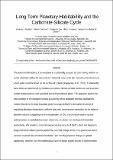Long-term planetary habitability and the carbonate-silicate cycle
Abstract
The potential habitability of an exoplanet is traditionally assessed by determining whether its orbit falls within the circumstellar "habitable zone" of its star, defined as the distance at which water could be liquid on the surface of a planet (Kopparapu et al., 2013). Traditionally, these limits are determined by radiative-convective climate models, which are used to predict surface temperatures at user-specified levels of greenhouse gases. This approach ignores the vital question of the (bio)geochemical plausibility of the proposed chemical abundances. Carbon dioxide is the most important greenhouse gas in Earth's atmosphere in terms of regulating planetary temperature, with the long-term concentration controlled by the balance between volcanic outgassing and the sequestration of CO2 via chemical weathering and sedimentation, as modulated by ocean chemistry, circulation, and biological (microbial) productivity. We developed a model that incorporates key aspects of Earth's short- and long-term biogeochemical carbon cycle to explore the potential changes in the CO2 greenhouse due to variance in planet size and stellar insolation. We find that proposed changes in global topography, tectonics, and the hydrological cycle on larger planets result in proportionally greater surface temperatures for a given incident flux. For planets between 0.5 and 2 R⊕, the effect of these changes results in average global surface temperature deviations of up to 20 K, which suggests that these relationships must be considered in future studies of planetary habitability.
Citation
Rushby , A J , Johnson , M , Mills , B J W , Watson , A J & Claire , M W 2018 , ' Long-term planetary habitability and the carbonate-silicate cycle ' , Astrobiology , vol. 18 , no. 5 , pp. 469-480 . https://doi.org/10.1089/ast.2017.1693
Publication
Astrobiology
Status
Peer reviewed
ISSN
1531-1074Type
Journal article
Description
A.J.R. would like to recognize the support of a Dean's Fellowship at the University of East Anglia, under which most of this work was produced, as well as an appointment to the NASA Postdoctoral Program at NASA Ames Research Center, administered by Universities Space Research Association under contract with NASA, where the model was updated and paper compiled. B.J.W.M. acknowledges a University of Leeds Academic Fellowship.Collections
Items in the St Andrews Research Repository are protected by copyright, with all rights reserved, unless otherwise indicated.

